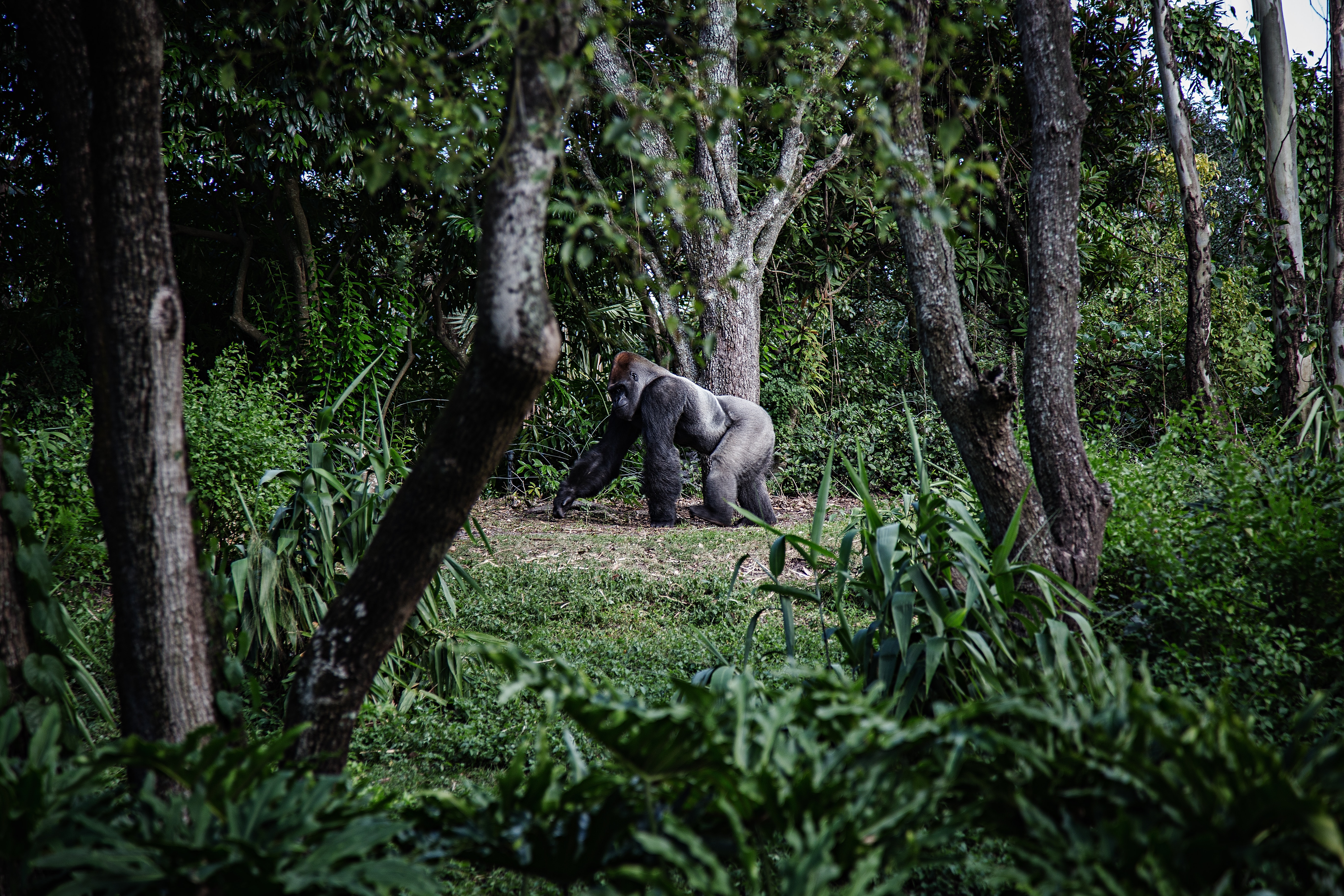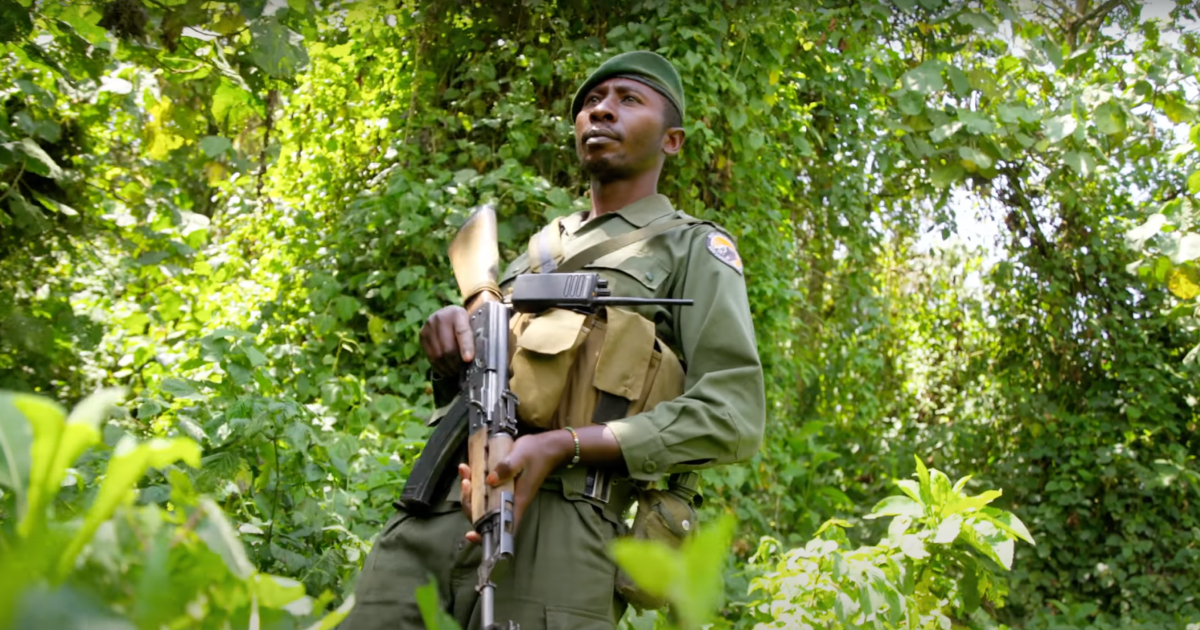In the eastern Democratic Republic of Congo, a war is being waged in and with the forest. This immensely rich and diverse environment all too often remains impenetrable to global attention and public awareness, but its remarkable story deserves to be amplified.
Providing a backdrop to volcanic eruptions, ebola outbreaks, oil prospecting and civil war, lies Africa’s oldest and most biodiverse national park, Virunga. Part of the Congo Basin - the world’s second largest area of tropical rainforest - this park is home to a third of the world’s remaining mountain gorillas. Elephants, buffalos and antelopes roam its savannah while hippos wallow in the expansive Lake Edward.
 Virunga is home to a third of the world’s mountain gorillas
Virunga is home to a third of the world’s mountain gorillas
Pillaging and patrols
The park and its wildlife, including its iconic gorillas, have, however, been caught in the midst of decades of violent conflict and subject to the incessant pillaging of its natural resources. Armed ranger details now patrol the park 24 hours a day and a nightly curfew is imposed in attempts to preserve this remarkable landscape against the illegal trafficking of its raw materials and riches.
 The park’s riches are being incessantly pillaged
The park’s riches are being incessantly pillaged
Virunga’s Lake Edward was once home to the largest population of hippos on the planet, with an estimated 27,000 of these keystone species providing life-sustaining nutrients to the lake’s ecosystem. By the late 1990s, almost 99% of these hippos had disappeared to poaching, targeted by anyone with a gun looking to make vast amounts of fast cash.
 Lake Edward once supported the world’s largest population of hippos
Lake Edward once supported the world’s largest population of hippos
Ancient forest under fire
But, it is the devastating, illegal logging of thousands of acres of the gorilla’s precious forest habitat that is literally the most burning issue. Ecosystems hundreds of years in the making are being set alight and cleared for charcoal that can be sold to local communities as fuel. This $40 million-a-year black market provides the local militia with their main revenue source and with an absence of infrastructure and alternative energy sources, reliable demand is ensured by basic human requirements, such as boiling water or cooking.
 Illegal logging for charcoal is the burning issue
Illegal logging for charcoal is the burning issue
As the local population has rocketed, partly due to mass migration following the Rwandan genocide, demand has soared. There is a desperate need for clean energy to curb the destruction of one of the world’s most climate-productive environments, before it reaches tipping point. Yet, despite being recognised as a UNESCO world heritage site in which extractive activities are forbidden, the DRC government has auctioned oil and gas exploration blocks within its borders. Thankfully, hope comes in a vastly less-invasive guise.
 The hydroelectric plant harnesses the power of the river with minimum impact on the ecosystem
The hydroelectric plant harnesses the power of the river with minimum impact on the ecosystem
Hydroelectricity sparks hope
Enter the Matebe hydroelectric plant, powered by the Rutshuru River running from Lake Edward through the Virunga National Park. It generates 14 megawatts of electricity - enough energy for 1.5 million people living in the nearby city of Goma. Crucially, there’s no dam, so there’s minimal effect on the surrounding environment, but it is already providing street lighting and constant, free electricity for the local hospital.
 Hydroelectricity provides free power to the local hospital
Hydroelectricity provides free power to the local hospital
The hope is to create 8 power plants like this to generate over 100 megawatts of electricity by 2040. Not only could this meet the energy demands of the 4-5 million people that are now living in villages and cities around the park. It would also create thousands of sustainable jobs that could bring young workers out of the militia and redirect their efforts into protecting the area’s rich natural resources thereby bringing greater stability to the region.
 The aim is to create a green economy of up to 100,000 jobs
The aim is to create a green economy of up to 100,000 jobs
The fight for funding
Another, bigger, hydroelectric plant is under construction in nearby Rwanguba, but it is plagued by the on-going fighting, which halts work and claims lives. In the interim, the rangers at Virunga remain the front line in ensuring there is a park left to protect. Their dedication to the park’s wildlife is inspirational.
 Armed rangers are the front line, but are desperately underfunded
Armed rangers are the front line, but are desperately underfunded
This fight goes beyond wildlife, however, with the forest essential to the lives of millions of local people and vital in the battle against global climate change. And yet, the ranger program remains desperately underfunded. At Glasgow’s COP26, donors made a historic pledge of $500M over five years to the region, but that figure is less than 15% of its estimated climate finance needs by 2030.
Investing in our future
Elsewhere, the opportunity for both longer-term financial and environmental gain is being made clear by the ever-increasing pace of the green economy. But, as Climate Week recently underlined, vastly unequal subsidies continue to be directed towards fossil fuel companies rather than renewables.
In a 30-year career caring for Virunga, director Emmanuel de Merode is a convincing proponent of how this renewable energy project can transform the area. Having survived an assassination attempt in 2014, his resolve to succeed is stronger than ever. He asserts that the economic value of the park has the potential to be much greater as a protected area, with the ability to reap over a $1 billion a year from tourism, fisheries and hydropower. A project profitable for both people and the planet.
 Wildlife tourism and renewable energy could make the park more profitable
Wildlife tourism and renewable energy could make the park more profitable
It remains a constant struggle against lack of direct funding, short-term gains and cycles of devastating violence and destruction. But, this hydroelectric initiative has sparked hope. Renewable energy can provide a lasting force to be reckoned with here, bringing power to the park, power to the people and power to change.
Will you join the movement?
Article by Lauren Holford
Published on November 15, 2023
Share this blog post with your folks, and help them find a career to be proud of.



